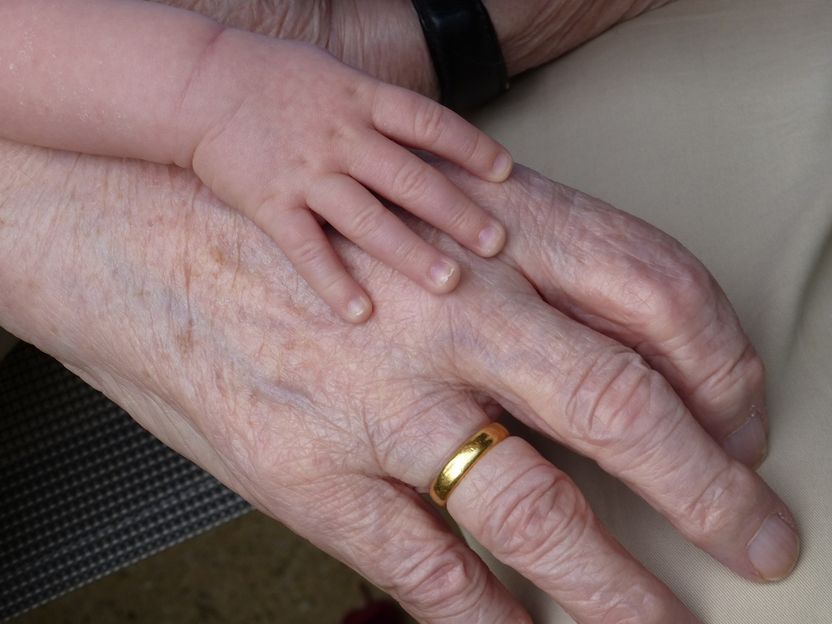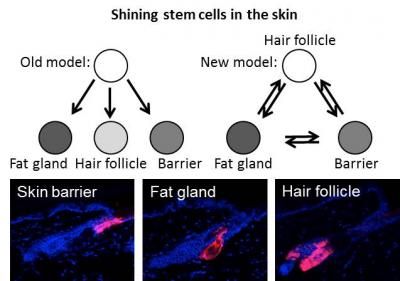Stiffness of skin tissue determines renewal capacity
New insights into the causes of aging
Advertisement
An international team of researchers from the Universities of Cologne and Helsinki have discovered that the ability of stem cells to proliferate and renew organs is regulated by the stiffness of the surrounding tissue. This finding may have implications for improving the regeneration of aged tissue. The cooperative study found that the stiffness of aged tissue increases, resulting in compromised stem cell function in the skin. In an animal model, the researchers showed that old stem cells can, however, regain their functions when cultured in a youthful environment, indicating that modulating the mechanical properties of the tissue might be an effective way to boost stem cell function in aged tissues.

Old and young skin stem cells are both capable of renewing the skin and its hair follicles. A slower renewal turnover of aged skin and its hair follicles may be caused by the decreased elasticity of skin tissues surrounding the stem cells (symbolic image).
pixabay.com
The team was led by Professor Dr Sara Wickström and included researchers from the CECAD Cluster of Excellence in Aging Research, the Max Planck Institute for Biology of Ageing, Collaborative Research Centre 829 ‘Molecular Mechanisms Regulating Skin Homeostasis’, the Center for Molecular Medicine Cologne (CMMC) University Hospital Cologne (all in Cologne), and the University of Helsinki.
The skin and its hair follicles are continuously renewed to maintain their function as a protective barrier between the outside world and our bodies. This constant tissue turnover depends on the activity and health of specialized stem cells that reside in the skin epidermis and hair follicles. Compromised function or a reduced number of stem cells leads to aging. ‘Although the critical role of stem cells in aging is established, little is known about the mechanisms that actually impair stem cell functions in aged tissue. The hair follicle with its well-understood functions and clearly identifiable stem cells was a perfect model system to study this important question,’ said Sara Wickström.
To understand what made aged stem cells functionally distinct from their young counterparts, the team investigated the differences in how the DNA is packed into chromatin in aged and young hair follicle stem cell populations. ‘Intriguingly, chromatin in aged stem cells was less accessible, especially around genes that are critical for stem cell activation and cell renewal,’ said Dr Janis Koester, the leading scientist of the study.
The follow-up analyses revealed that this decreased accessibility resulted in less efficient responses of the stem cells to a regenerative signal and thus delayed activity to renew the hair follicle. ‘Surprisingly, the compromised functionality of the stem cells could be fully restored by transplanting them into young recipient mice, suggesting that the aged microenvironment, and not a defect in the stem cells themselves, was the primary cause of aging,’ explained Koester.
The researchers went on to study what could be different in young and old skin using mass spectrometry to quantify global differences in protein levels. ‘We observed that most alterations were connective tissue components and specifically proteins that are important to the mechanical properties and structural integrity of skin,’ Dr Yekaterina Miroshnikova, the second lead author, said. This led the team to hypothesize that despite macroscopically being lax and fragile, aged connective tissue, and particularly the basement membrane, a specialized connective tissue structure that the stem cells are attached to, could be stiffer than younger tissue. This hypothesis was confirmed by mechanical measurements.
Finally, to test if the stiffening could indeed regulate stem cell function, the researchers purified the connective tissue from skin biopsies of young and old mice and observed that young connective tissue was able to promote self-renewal of both young and old stem cells, whereas aged connective tissue failed to do so. In addition, mice with genetic mutations in Collagen XIV and Tenascin X that rendered the hair follicle stem cell microenvironment within the skin stiffer showed premature decline of stem cell function.
‘A major future goal will be to understand how these preclinical findings might translate into stem cell aging and functional decline in humans,’ said Wickström. ‘We are particularly intrigued about the observation that mutations in Collagen XIV and Tenascin X impair stem cell functions, since mutations in Tenascin X also cause a human disease, the Ehlers-Danlos Syndrome, where patients suffer from a macroscopically hyper-elastic, but very fragile skin that does not heal well.’ These types of problems are also associated with normal aging. The results of this research could indicate that the altered mechanical properties of the stem cell microenvironment are an important feature of many diseases and might thus be important to target therapeutically.
Original publication
Koester J, Miroshnikova YA, Ghatak S, Chacón-Martínez CA, Morgner J, Li X, Atanassov I, Altmüller J, Birk DE, Koch M, Bloch W, Bartusel M, Niessen CM, Alvaro Rada-Iglesias A, Wickström SA; "Niche stiffening compromises hair follicle stem cell potential during ageing by reducing bivalent promoter accessibility"; Nature Cell Biology; 2021


























































